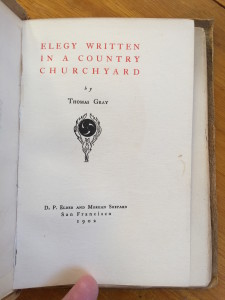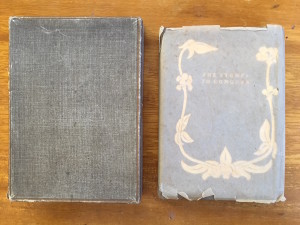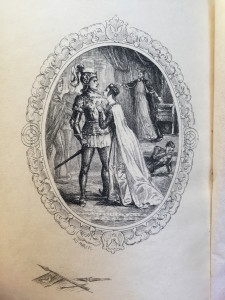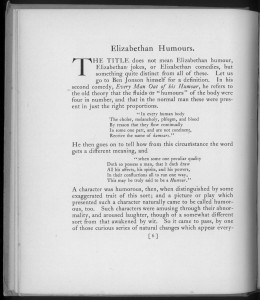
Book series that gather and reprint public domain fiction have a long history. Perhaps the earliest series was Poets of Great Britain Complete from Chaucer to Churchill, founded by British publisher John Bell in 1777. Later British series included Routledge’s Railway Library (1848–99) and the Everyman’s Library (1906-). A well-known American example is the Modern Library (1925-70). Book series were a familiar sight at any turn-of-the-century bookstore.
Paul Elder published several such series. The first and largest was the Impression Classics in 1902, under the Elder & Shepard imprint. It was just one of the many items in the Elder catalog to bear the “Impression” name.
Impression Classics. A selected series of the shorter gems of literature. Beautifully printed on deckle-edged paper, with title page in two colors and etching frontispiece on Japan vellum. Bound in flexible grained lambskin with original design. Boxed. $1.25 net.
There were originally twenty-four titles in the series, numbers 1-24 on the list below. In 1904, as Paul Elder & Company, he reissued the series while adding twelve more titles, bringing the total to thirty-six.

- Selections from Marcus Aurelius, by Marcus Aurelius
- Selections from Fénelon, by François Fénelon
- Reflections and Moral Maxims, by François de La Rochefoucauld
- Letters to His Son, by Lord Chesterfield
- Friendship and Love, by Ralph Waldo Emerson
- Heroism and Character, by Ralph Waldo Emerson
- Sweetness and Light, by Matthew Arnold
- Virginibus Puerisque, by Robert Louis Stevenson
- Poor Richard’s Almanac, by Benjamin Franklin
- Wit and Wisdom of Sidney Smith, by Sydney Smith (misspelled “Sidney” on the cover and title page)
- Milton, by Thomas Babington Macaulay
- Sir Roger de Coverley, by Joseph Addison
- Old Christmas, by Washington Irving
- Rip Van Winkle and Legend of Sleepy Hollow, by Washington Irving
- Rab and His Friends, and Marjorie Fleming, by Dr. John Brown (misspelled “Majorie” on the cover and title page)
- A Christmas Carol, by Charles Dickens
- Sonnets From the Portuguese, by Elizabeth Barrett Browning
- Rubaiyat of Omar Khayyam, by Edward Fitzgerald
- Enoch Arden, by Alfred, Lord Tennyson
- The Vision of Sir Launfal, by James Russell Lowell
- Selections from Leaves of Grass, by Walt Whitman
- Elegy Written in a Country Churchyard, by Thomas Gray
- The School for Scandal, by Richard Brinsley Sheridan
- She Stoops to Conquer, by Oliver Goldsmith
- Addresses and Anecdotes, by Napoleon Bonaparte
- Selections from the Prose of Honoré de Balzac, by Honoré de Balzac
- Poems of Sentiment, by Lord Byron
- Some Fruits of Solitude, by William Penn
- Will o’ the Mill, by Robert Louis Stevenson
- Men and Women, by Robert Browning
- The Destruction of Pompeii, by Edward Bulwer
- Golden Wings, by William Morris
- Evangeline, by Henry Wadsworth Longfellow
- Selections from Epictetus, by Epictetus
- The Holy Grail, by Alfred, Lord Tennyson
- Selected Poems, by John Boyle O’Reilly

The title page (see photographs above) distinguishes between the 1902 and 1904 editions. As was the case with other series published by Elder, instead of printing the books at the Tomoye Press he bought the sheets elsewhere. In the case of Impression Classics, the sheets are known to come from H. M. Caldwell’s Remarque Edition of Literary Masterpieces series, first published in 1900. For example, the frontispiece and text of title #18, Rubaiyat of Omar Khayyam, is page-for-page identical to the Remarque Rubaiyat. Only the title page and cover designs are Elder’s. While the 1902 printings read “Printed by The Stanley-Taylor Company, San Francisco” and the 1904 printings read “The Tomoyé Press, San Francisco,” those presses only provided the leaf containing the title and printer’s name, and that bearing the half-title. Caldwell’s name is not mentioned anywhere in the Elder imprints. There are at least 57 titles in the Remarque series, but Elder only purchased 36 of them.

There are five known cover designs, which I have labelled A-E (see photograph). Covers A, B, and C were almost certainly designed by Morgan Shepard, and are the only covers which have been seen on the 1902 imprints. Cover D was designed by Spencer Wright—as cited in the 1904 Catalog From a Western Publisher—strongly suggesting that Cover E is Wright’s as well. (Cover D is nearly identical to that of volumes 5 and 6 of Impressions Quarterly magazine.)
Of the copies I have examined, covers A-B have only been seen on the 1902 edition, covers D-E only on the 1904 edition, and cover C on both. But as the photo at right demonstrates, at least one copy of Poems of Sentiment, which was only issued in the 1904 edition, was issued with cover A. As a result of all this, some titles have been seen in multiple covers: for example, Elegy Written in a Country Churchyard in covers C and D, and Poems of Sentiment in covers A and E. It’s unknown whether there was any reason behind why a given title appears with a given cover design.
The 1902 edition was advertised as being bound in “full flexible suede leather” and the 1904 edition in “full flexible grained lambskin,” and with two exceptions this holds for all the copies I have seen. All examined copies have top edge gilt. The bindings were also issued in three different colors: brown, green, and red. However, over the decades many green covers have faded to brown, sometimes leaving only a smudge of green on back cover or on the inside surfaces of the covers along the edge of the endpapers (note the fading in the Cover C example in the photograph above). So far, the red binding has only been seen on the 1902 edition.
The title pages are in two colors and include one of two tomoyé designs, depending on whether the title is the 1902 or 1904 printing. There is a half-title page containing the text “Impression Classics.” Many copies have endpapers containing strips of bark, something Elder used in a number of his other publications. The leather is good quality and has held up reasonably well, much better than the Panel Books, for example. The books were sold in unmarked boxes, protected by an unmarked glassine dust jacket, neither of which typically survive.
In December 2020, I was able to identify the frontispiece artist, previously known only by the signature “AD MARCEL,” as French artist Adrien Marcel. All of the frontispieces in the series are by Marcel, though not all are signed by him; of the twenty-two titles I have examined, two are unsigned.

Some of the titles include a short introduction or “prefatory remarks,” usually anonymous. The signed introductions that have been seen so far are:
- Chesterfield’s Letters To His Son (#4), by “J. H. F.,” identity unknown
- Fitzgerald’s Rubaiyat (#18), by “M. K.” (Michael Kearney). Kearney was a Persian scholar who, in addition to the long (33 pages) introduction in the book, also translated many of Khayyam’s quatrains.
- O’Reilly’s Selected Poems (#36), by William A. Hovey. Hovey (1841-1906) was a newspaper editor in Boston, and evidently a good friend of the poet.
I would like to thank Roger Paas for details about both Michael Kearney and Caldwell’s Remarque Edition series.





